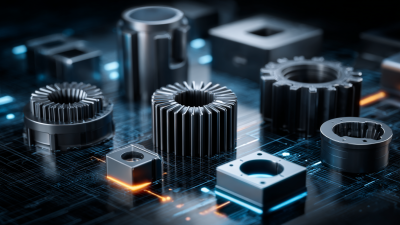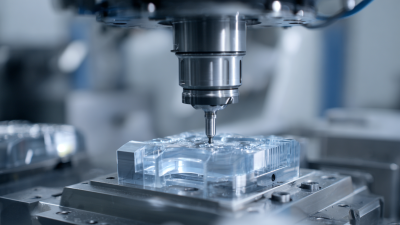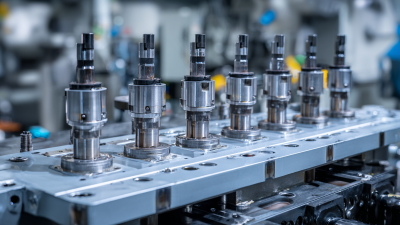
The Future of Injection Tooling Innovations and Opportunities
As we venture into an era marked by rapid technological advancements, the landscape of injection tooling is poised for significant transformation. This blog explores the future of injection tooling innovations and the myriad opportunities that lie ahead, driven by cutting-edge technologies such as automation, artificial intelligence, and sustainable practices.

With industries increasingly demanding precision, efficiency, and environmentally friendly solutions, it is essential to recognize the digital revolution that is reshaping injection tooling processes. By examining the reasons behind these innovations, we will uncover how they not only enhance productivity but also contribute to greater sustainability and adaptability in manufacturing.
Join us as we delve into the key drivers of change and the exciting prospects that injection tooling holds for the future.
The Rise of Digital Technologies in Injection Tooling
The rise of digital technologies in injection tooling is reshaping the landscape of manufacturing, driving efficiency and innovation in unprecedented ways. According to a recent report by MarketsandMarkets, the global market for industrial automation and digital transformation in manufacturing is expected to grow from $214 billion in 2022 to $384 billion by 2027, reflecting an annual growth rate of 12.4%. This surge is significantly influenced by the adoption of advanced digital technologies such as IoT, AI, and machine learning, which are increasingly integrated into injection moulding processes.
To maximize the benefits of these digital advancements, manufacturers should consider adopting predictive maintenance systems. By leveraging IoT sensors and data analytics, businesses can monitor equipment performance in real-time, predicting potential failures before they occur. This proactive approach reduces downtime and enhances operational efficiency, ultimately leading to cost savings.
Moreover, embracing simulation software is vital for optimizing design processes in injection tooling. A study by Deloitte indicates that companies utilizing digital twins and simulation technologies can decrease product development time by up to 30%. By simulating the injection moulding process before actual production, manufacturers can identify and rectify potential issues early, streamlining their workflows and improving overall product quality.

Current Market Trends and Growth Projections for Injection Tooling
The injection tooling industry is experiencing a significant transformation driven by technological advancements and increasing demand across various sectors. According to a recent report by MarketsandMarkets, the global injection molding market is projected to reach USD 310.8 billion by 2026, growing at a CAGR of 4.8% from 2021. This growth is largely attributed to the rising need for lightweight and energy-efficient products, particularly in the automotive and consumer goods industries. As manufacturers strive to improve production efficiency and reduce time-to-market, innovations in tooling materials and designs have become paramount.
Notably, the adoption of Industry 4.0 technologies is reshaping injection tooling processes. The incorporation of IoT and automation within tooling systems allows for real-time monitoring and predictive maintenance, significantly enhancing operational efficiency. According to a study by Grand View Research, the injection molding machine market size alone is expected to surpass USD 20 billion by 2025, driven by these automation trends. Furthermore, the push towards sustainable manufacturing is prompting companies to invest in eco-friendly tooling solutions, such as biodegradable materials and energy-efficient machines, aligning with broader environmental goals. As these trends continue to evolve, the injection tooling sector is poised for robust growth and innovation opportunities.
The Future of Injection Tooling Innovations and Opportunities
Innovative Materials Shaping the Future of Injection Molding
Innovative materials play a crucial role in shaping the future of injection molding, driving advancements in performance and sustainability. As industries increasingly prioritize eco-friendly practices, bioplastics and recycled polymers are gaining traction. These materials not only reduce the carbon footprint but also enhance product performance, offering the flexibility and strength required for modern applications. Biodegradable options are becoming particularly popular, as they cater to environmentally conscious consumers while meeting stringent regulatory standards.

Moreover, the integration of smart materials into injection molding opens new avenues for functionality. Thermochromic and shape-memory polymers are examples of how innovation can create products that respond dynamically to environmental stimuli. This capability allows for the development of self-regulating devices and packaging that can signal when they are no longer effective. Such advancements not only enhance user experience but also lead to more efficient resource management throughout the product lifecycle, indicating a promising intersection between technology and material science in injection tooling.
Sustainability: Reducing Waste in Injection Tooling Processes
In recent years, the injection tooling industry has witnessed significant innovations aimed at enhancing sustainability. Among these, low-pressure injection molding has emerged as a transformative technology that reduces energy consumption and minimizes waste, supporting a more environmentally friendly plastic manufacturing process. This technique not only lowers production costs but also addresses the increasing demand for sustainable practices. Research shows that employing low-pressure methods can reduce scrap rates significantly, leading to a circular economy model where waste is drastically minimized.
Additionally, the integration of 3D printing with upcycled plastics and biomass waste is reshaping material inputs in injection molding. A recent study highlighted the potential of combining recycled polymers with natural waste materials, promoting innovative biocomposites that meet rigorous performance standards while minimizing environmental impact. This approach not only allows manufacturers to utilize existing waste streams effectively but also opens avenues for new product development that aligns with sustainability goals. By optimizing injection molding parameters and focusing on waste reduction strategies, the industry is making strides toward a greener future, ultimately supporting global sustainability initiatives.
Emerging Opportunities through Automation and AI in Tooling Solutions
As the injection tooling industry evolves, automation and artificial intelligence (AI) are emerging as pivotal forces driving innovation and efficiency. According to a recent report by MarketsandMarkets, the global injection molding market is projected to reach USD 450 billion by 2026, with a significant shift towards automation technologies. This shift not only reduces production costs but also enhances precision and speed, allowing manufacturers to stay competitive in an ever-changing marketplace.
To capitalize on these emerging opportunities, businesses must consider the implementation of AI-driven tooling solutions. AI can streamline the design and prototyping phases, thereby shortening lead times and reducing material waste. For instance, Generative Design—an AI technique—optimizes for strength, weight, and material costs, resulting in tools that are not only cost-effective but also innovative in design.
**Tips:** Regularly evaluate your tooling processes and look for automation solutions that integrate seamlessly into your existing system. Prioritize training your staff on AI technologies to ensure a smooth transition. Additionally, conduct periodic assessments of new market innovations to keep your tooling solutions at the cutting edge. By embracing these advancements, companies can position themselves to thrive in a landscape defined by efficiency and innovation.
The Future of Injection Tooling Innovations and Opportunities
| Innovation Type | Description | Emerging Opportunities | Impact of Automation & AI |
|---|---|---|---|
| Smart Tooling Systems | Integration of IoT in tooling for real-time monitoring and optimized performance. | Increased efficiency and reduced downtime. | AI algorithms analyze data to predict maintenance needs, increasing uptime. |
| Additive Manufacturing Techniques | Using 3D printing to create complex injection molds faster and cheaper. | Customization and faster prototyping. | Automation reduces manual labor and speeds up production processes. |
| Digital Twins | Virtual model of the injection process to simulate and optimize performance. | Enhanced decision-making through predictive insights. | AI analyzes performance data to improve process parameters. |
| Robotics in Tooling | Utilization of robots for handling and precision tasks in tooling. | Higher precision and safety in manufacturing environments. | Robotic systems can be enhanced with AI to adapt to varying tasks. |
| Sustainable Materials | Development of eco-friendly materials for injection molding processes. | Reduced carbon footprint and recycling opportunities. | AI optimizes material selection and usage based on lifecycle analysis. |
Related Posts
-

Exploring the Benefits and Applications of Various Injection Molding Products in Today's Industry
-

Quality Driven Global Success of Prototype Injection Molding from China
-

Creative Examples of Successful Injection Molding Applications Across Industries
-

Exploring Innovative Alternatives to Injection Moldable Plastics for Sustainable Production
-

5 Key Benefits of Investing in Injection Tooling for Global Buyers
-

Common Challenges Faced in Mold Plastic Injection Processes
